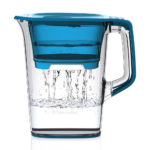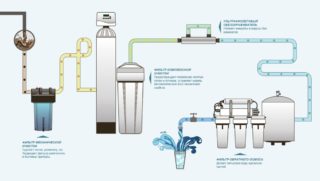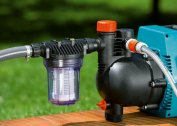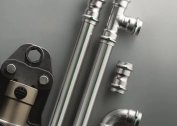Fluid from a well, well and water supply system is almost never perfect: there is a large amount of salts, suspensions, sometimes capable of harming health. To make drinking water clean, tasty and safe, you will need to install a cleaning system.
Types of cleaning systems
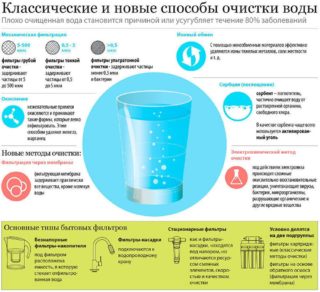 The process of cleaning the liquid depends on the type of impurities. Concentration will reveal a laboratory test. The water treatment of a private house can go through four stages of purification:
The process of cleaning the liquid depends on the type of impurities. Concentration will reveal a laboratory test. The water treatment of a private house can go through four stages of purification:
- Rude. Coarse suspensions are removed by mesh or filling filter elements.
- Chemical. Filtered compounds of iron, manganese, heavy metals and hydrogen sulfide, water softens. For this, ion exchange devices, aeration columns, and iron removal plants are used.
- Bacterial. When processed with ultraviolet or ozone, fragments of organics and microorganisms are removed.
- Thin. Maximum cleaning occurs using sorbent columns and membrane systems.
The last two stages can be combined using environmentally friendly devices for ultrafine cleaning by reverse osmosis.
Reagent and non-reagent
Water treatment systems are reagent and non-reagent. First, oxidizing substances are used, which react with contaminants, in particular with glandular compounds. Wastewater treatment plants of this kind are not too expensive, but they require cash injections during operation to maintain productivity.
Filters are able to clarify the liquid so that it becomes suitable for hoarseness. But drinking purified water in its raw form is not recommended.
Reagent-free devices are expensive, in addition, they need to install an air compressor device and aeration columns. Treatment systems are more cost-effective compared to reagent systems, since there is no need to spend money on consumables. The devices can dispense purified water, suitable for use in household needs, for drinking and cooking.
Dimensions and arrangement of filtration equipment
For summer cottages, the use of such filter elements is possible:
- The filter jug is a cleaning plastic dish with a cartridge installed inside. It is inexpensive. The level of treatment is medium, a good option with a small amount of water. It will not protect against all impurities, but it will delay the compounds of chlorine and iron, small grains of sand and organic particles. When choosing a cartridge device, you will need to consider the composition of the water. Boxes with jugs indicate which contaminants the filter can hold.
- Attachment on the crane. This is a small plastic element with a filter substance. It takes up little space and is very cheap. Install it on the mixer, fasten with clamps or screw onto a thread. The filter element of this plan helps to clean the liquid from lime, chlorine and rust, softens the water. But it slows down the water flow, which can lead to breakdown of the pumping equipment.
- Filter "under the sink." Cleans from various contaminants, but requires regular replacement of an activated carbon cartridge.
- Sink filter
- Attachment on the crane
- Jug
For a small house, it is enough to install a coarse screen mesh membrane on the pump and put a cartridge-type flow-through filter element. The mesh will trap large contaminants, and the filter with a cartridge will contain fine impurities and suspensions, chloride and glandular compounds.
For a typical suburban cottage, an integrated device consisting of filter nodes is suitable:
- mud filter for cleaning large impurities;
- aeration column producing oxidation of ferrous and hydrogen sulfide impurities;
- iron remover for trapping compounds of iron, manganese and heavy metals;
- a softener that makes the liquid less stiff.
If necessary, such a complex can be supplemented with a fine filtering device, as well as disinfecting equipment.
Criterias of choice
To choose the equipment that suits you, you need to consider the following indicators:
- Water quality. You will need to take a sample for laboratory testing. If the water contains a significant amount of coarse impurities, you will need a mesh filter with large cells of 400 microns. The use of thinner filtration elements is impractical because of their instant failure.
- The amount of water consumed. A person needs 2.5 liters of drinking fluid per day. To calculate the required volume, the figure is multiplied by the total number of residents of the house.
- Dimensions of equipment. The indicator is directly related to the productivity of the device. This aspect should be taken into account already at the stage of creating a house project in order to find a site for the device. There are miniature cabinet-type water purification stations, compact block installations, modular and block-modular sets. The latest water treatment devices are large-sized and suitable for cottages with extensive areas.
- Degree of automation. Stations can be operated in standard mode and in conditions of regeneration of filtration load. Periodically switching the installation is required. Perform it manually or using automation. The first method is inexpensive, but labor-intensive. In the second version, the system is equipped with a control valve, which greatly simplifies the maintenance and repair of equipment.
- The cost of the device, its installation and consumables.
After passing through the filtration unit, the water loses not only harmful, but also useful properties. For such cases, devices have been developed that saturate liquids with necessary substances.
Installation Steps
Arrangement of an independent treatment plant begins with the selection of premises. For non-stop year-round functioning of the system, it must be installed in a room with heating. In those cases when they live in a country house only in the warm season, you can put water filters, which provide for conservation for the winter.
It is not necessary to clean all the liquid entering the house. Perfectly pure water is required for drinking and cooking.
Cleaning devices lead to a separate kitchen faucet. To provide additional protection for the device from contaminants, several coarse filtration devices can be installed at the inlet of the water main.
Installation of a water treatment system is carried out according to the following scheme:
- Installation and fixing of the elements of the water purification kit. They are connected in series with each other by means of an eyeliner and fittings.
- Connection to communication networks - power supply, sewerage, as well as to the water supply network of the house. A shut-off valve must be installed on the connection to the pipeline. Work with electrical equipment must be performed by an electrician with special approval.
- System test. An indispensable condition for its correct and uninterrupted functioning. At the test stage, they determine under what pressure the fluid moves in the system, check the actual throughput of the filter elements and find out if it is in accordance with the planned indicator.
All installation and connection work of the treatment system can be completed in about five hours.
You can order them from specialized turnkey organizations. This means the delivery of equipment, assembly, loading of filtration materials, test run and adjustment of all parts of the structure, analysis of purified water.
Entrust the execution of commissioning and commissioning work to professionals, especially when it comes to complex cleaning devices. It’s quite possible to put a small filter on your own.
Operation and maintenance
Regardless of the type of filtration device, it is necessary to systematically inspect the system for structural defects, loss of tightness and other malfunctions. Consumables and accessories require regular replacement.
Consumable filter elements are replaced on average once every three months.
If the water used in the cottage for irrigation and irrigation passes through the filters, it will be necessary to thoroughly rinse the internal surfaces of the equipment itself. The same applies to downhole filtering units operating continuously with contaminated fluid.
The cost of water treatment systems for a country house
The price of the simplest devices for a single purification of a small amount of water is about 1500 rubles. The cost of a comprehensive water treatment system in a private house starts at 20,000 rubles. The upper price limit is 600,000 rubles.
The cost is affected not so much by the functionality and design features of the treatment plants as the level of automation.
Also the price depends on the manufacturer. For example, Russian Akvafor devices with full cleaning and aeration deferrization cost about 130,000 rubles. Domestic installation "Christmas tree" - about 170,000 rubles. A similar version of the American brand EcoWater Systems - about 200,000 rubles.


